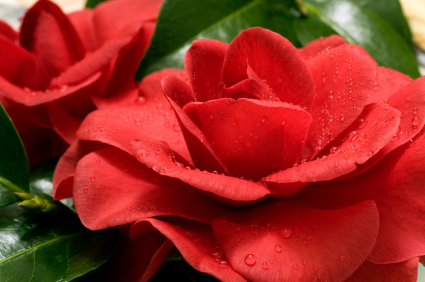Winter Gardens

Winter for most of us is a time for staying indoors relishing the warmth of open fires and hot food. As the temperature drops, so does the desire to be outdoors in the garden…. But a garden in winter does not need to be dreary and bare. Although a winter garden lacks the joy of flowers that spring can bring and the lush abundance of summer time foliage, there is still a wide choice of flowering trees, shrubs and winter annuals to bring some life into your garden. With some careful planning it is possible to create a winter garden that provides colour and interest during the cold season.
Planning
While inside on those cold rainy days, when the long hazy days of summer seem like a million miles away, start dreaming and planning how you want your garden to look not just in summer but all year round. Whether you have an existing garden that needs a renovation or you have new site that requires a new design from scratch, start putting some ideas down on paper or commission a professional landscape designer to create some plans for you. After the plan is complete, a lot of the structure and layout of the garden can be built in winter and planting can begin from autumn to early spring, then sit back and reap the rewards.
Creating winter colour
For a quick fix, add instant colour in the garden where summer perennials have gone dormant or where there are some bare spaces around trees or shrubs. If you like flowers, then winter annuals such as Polyanthus, Primula’s and Pansies give the garden an instant lift. Pansies come in all colours and sizes of flowers, so you can plan your winter colour schemes. For a quick fix, create a colourful entrance area using Polyanthus or try white Primula’s with their dainty open flowers. They look stunning en masse during winter. Plant in large drifts under trees or as a soft filler behind crisp clipped fomal hedging or plant in large containers for courtyards and decks. Winter annuals should be planted in March and April, while the soil is still warm. If foliage is your thing then choose from a wide range of native coloured flaxes or divaricating shrubs.
The beauty of trees and shrubs
Trees and shrubs add year round beauty and structure to the garden. For best results trees are best planted during the months of April through to September/October. This gives roots a chance to get established before the stress of long hot summer days set in. Deciduous trees give shade in the summer and lets in valuable sun during winter. Cool crisp days where the delicate bare skeletal form of a tree creates an amazing silhouette against the clear blue sky. The bark of a tree can also create some excitement in a winter garden. Try planting trees such as the Paperbark Maple or a Birch tree with bark that peels to produce a colorful display on their trucks. Evergreen trees add texture with their variation of leaf shapes and interesting forms. Early blooming Magnolia denuata and M. Stella provides valuable additional colour in the late winter. The winter flowering cherry Prunus subhirtalla autumnalis ‘Rosea’ has delicate shell pink blooms. This beautiful small tree puts on a gorgeous display and is particularly suited to woodland areas. Some on our own New Zealand natives provide colour during the dullest winter months. Leptospernum varieties put on a colourful display with red, pink or white flowers. Kowhai Sophora ‘Dragons Gold’ or ‘Early Gold’ has delicate gold/yellow flowers. Hebe ‘Wiry Mist’ has flush of magenta colored flowers in early winter and H. ‘Lavender Lace’ has mauve-white flowers.
Banksias are an Australian native, the winter flowering varieties have flowers which nectar feeding birds such as Tuis love to feed from. Proteas and Leucadendrons from Africa put on a bold display through winter and spring and also make wonderful cut flower displays for inside the home.
If you live in warmer parts of the country then you can’t go past planting Michela doltsopa or Gordonia axillaris, both have lovely white flowers. M. Doltsopa has a fruity lemony fragrance.
Tropical and succulent plants
In the north where winters are milder, there are a range of subtropical plants and succulents that give the garden plenty of colour in winter. Aloe thraskii produces stunning yellow flowers and Aloe arborescens has vivid orange flowers. Another plant to try is Bromeliads. They come in a variety of colours with stripes or spots and can grow in a variety of conditions from deep shade to full sun. Tibouchina urvilleana ‘Edwardsii’ it is an easy care shrub that has vivid purple flowers. Abutilons are another versatile shrub that produces red or yellow winter flowers.
Old time classics
And finally you just can’t beat old-time classic favourites such as Camellias, Azaleas, Rhododendrons, Daphne and Hellebores (Winter rose) and Lavendula dentate (lavender). These plants provide colour and fragrance in a winter garden. Camellia sasanquas are suitable for espalier and hedging. Camellia japonicas are perfect for open, larger gardens. They come in various shades of pink, white and red. Daphne has a perfume that will fill and sweeten the chilly air, so plant near the entrance or an outdoor seating area. Hellebores are an evergreen perennial that looks great massed underneath trees. They also do well out in the full sun and will produce a wonderful display of flowers.
Plants offer a unique beauty within the winter garden. Adding garden accessories such as benches, arbors, water features, garden sculptures and statues will further create lasting permanent points of interest.
www.flourishgardens.co.nz



